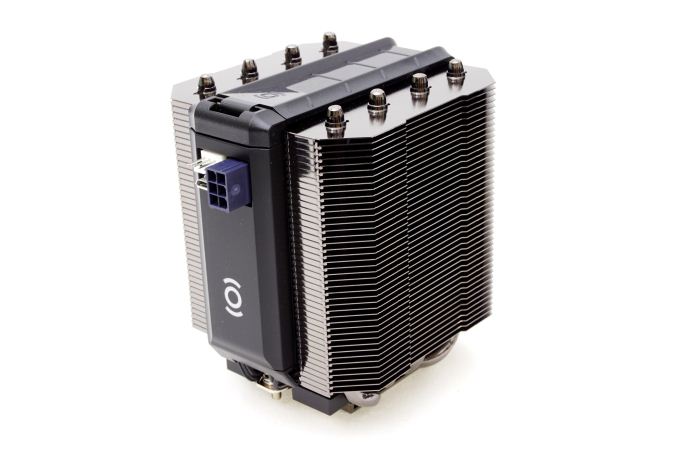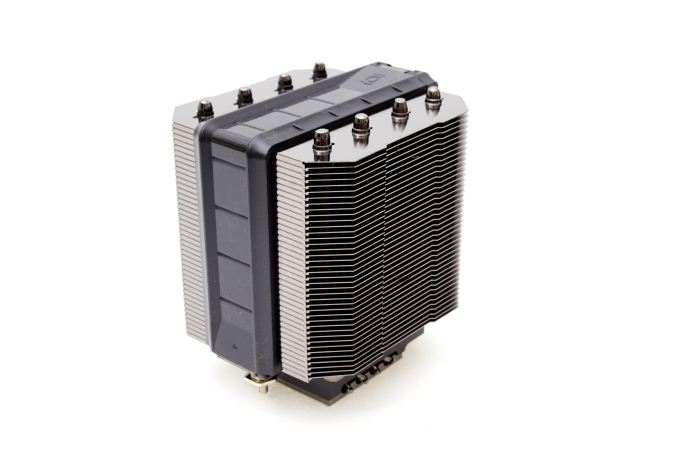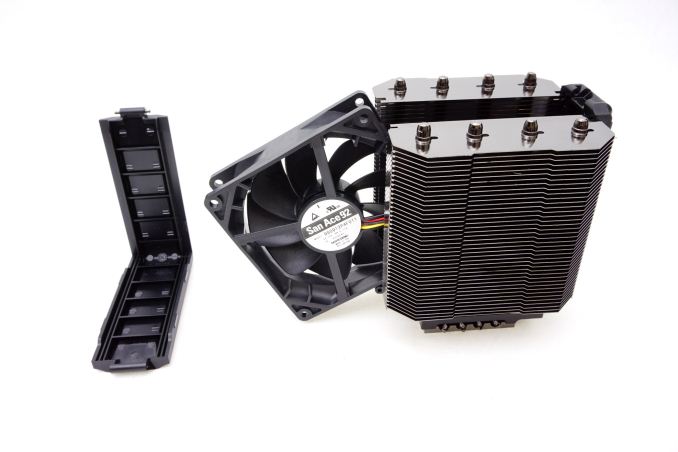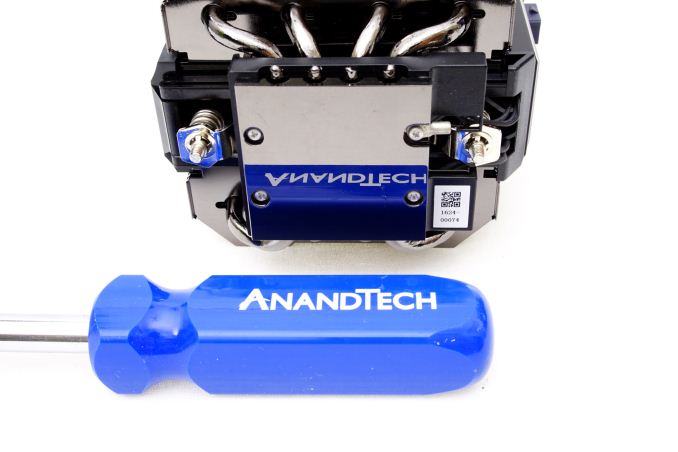The Phononic HEX 2.0 TEC CPU Cooler Review
by E. Fylladitakis on September 26, 2016 9:30 AM EST- Posted in
- Cases/Cooling/PSUs
- Cooler
- TEC
- Phononic
- HEX 2.0
The Phononic HEX 2.0 Thermoelectric Cooler
If not for the 6-pin PCI Express power connector at its side, the HEX 2.0 could be easily mistaken for a simple medium-sized tower cooler. It is only 12.5 cm tall and should fit in many narrow cases, where several top-tier air coolers cannot. The HEX 2.0 is a dual-tower design, with four heatpipes transferring the thermal energy from the CPU to two arrays of aluminum fins, and with the fan placed between the two fin arrays. In this case, Phononic also placed the control electronics in between the arrays and covered everything with a neat plastic frame.
Phononic put a significant amount of effort in the aesthetic design of the Hex 2.0. Both the aluminum fins and the copper heatpipes of the cooler are chromed. The tips of the heatpipes extruding above the fin arrays are perfectly symmetrical. Phononic also placed a very strong RGB LED inside the company logo beneath the connectors, the color of which is selectable via the control software (green by default).
The frame can be partially removed, revealing the 92 mm cooling fan and providing access to the mounting screws. It will have to come off in order to install the cooler, but it is not necessary to completely remove the fan as well.Note that the fan can be replaced but needs to be inserted in a specific direction, as marked on the base of the cooler. Phononic is using a very high quality Sanyo Denki San Ace 9S0912P4F011 fan. Even though it is part of Sanyo’s “Silent” range, this fan has a maximum speed of 2650 RPM and will be quite loud should it operate at maximum speed.
The base of the cooler consists of a chromed copper plate that comes in contact with the CPU and a black aluminum frame that provides mechanical cohesion. Its chromed copper base is virtually a nearly perfect mirror. The TEC and the heatpipes are sandwiches between the copper plate and the aluminum frame. A temperature sensor can also be seen attached to one of the screws holding the base together.
The Software
The HEX 2.0 Dashboard software is very straightforward and lightweight. Not even an installation is required, the software is a simple executable file that can be launched instantly once downloaded.
To the left of the screen, the user can check the “cooling power”, which indicates the power of the TEC. There are three cooling profiles to choose from: standard, insane and high ambient. The standard mode addresses most users, where the firmware of the cooler will be adjusting the power of the TEC according to the thermal load. Setting the cooler to insane mode will lock the TEC at maximum power and, as the warning message says, it can cause condensation under certain conditions. High ambient mode sets the TEC to activate at higher thermal loads only to prevent condensation in very humid environments.
















48 Comments
View All Comments
Communism - Monday, September 26, 2016 - link
The best way to do long term below ambient CPU or GPU cooling is to attach a mini-split (google it if you don't know what the term means) to a water cooling loop attached with a copper to copper [imagine something similar to interface between the IHS and the contact plate of a cooler] connection (To interface the mini-split to the water cooling loop without any fuss).This will simultaneously cool your CPU/GPU below ambient for extended periods of time while piping the heat directly outside your home.
hybrid2d4x4 - Monday, September 26, 2016 - link
This is more of a comment on your testing platform than this review, but it seems to me that your current setup has a few shortcomings.1) The testing platform isn't close enough to simulating the sockets of mobos to give any meaningful comment on how good the mounting mechanism is on the cooler. This is especially true of AMD socket.
2) The operating range for your thermal load isn't well suited to represent CPUs. IMO, it would be infinitely more useful to have something that ranges from 5-10W (~the idle state of a modern CPU if not less) to 100W (or whatever actual power draw an enthusiast OC setup would be). While interesting in an academic sense, testing up to 340W is completely irrelevant and beyond the design targets that these coolers were aiming for.
BurntMyBacon - Monday, September 26, 2016 - link
AMD FX-9000 series processors are rated for 220W. Processors consume more power at an exponential rate as more voltage is applied. Perhaps 340W is a bit much, but not as far off as you seem to think.That said, I would like to put in another vote for representing more lower power gradients. Common TDPs are something like 5W, 15W, 25W, 45W, 65W, 95W, 125W, and 140W. Higher TDPs like 180W and 220W are also present, though less common. You don't need to hit all of these TDPs, but just 60W probably isn't a good representation for everything under 100W.
DanNeely - Monday, September 26, 2016 - link
The crazy high TDPs are also reachable with aggressive overclocking and high end cooling.Sushisamurai - Monday, September 26, 2016 - link
I too second this opinion. I would like to see more temp gradients around the 60, 80, 100, 120, 140W of usage... A graph for these things would be nice if time was permitted, as when the author mentions thermal resistance/performance falling off, he's not very specific at what point does it "fall off" (eg: is it competitive at 60-100 but falls off at >120?). I imagine a lot of people use this site's data and opinions to shop for products, and having more gradients to align with purchase decisions would be nice. I know I have a 80W stock load, 120W Oc, 140W stock and 220-240W loads. Extrapolating your data is doable, but I think not everyone can. My re-verification numbers on my home hardware #'s are similar to the extrapolations and your test results, so I thank you.eldakka - Tuesday, September 27, 2016 - link
I'd also like to see lower TDP measurements. I'm not thinking of overclocking situations, but more HTPC-type situations, where with a good, quiet cooler you might be able to put a more powerful processor in the HTPC while still remaining quiet.This thing being chromed might look pretty cool in a HTPC sitting under a telly...a slimline case with a hole cut in the top for so the fins stick out the top, like a blower sticking out of the bonnet (hood) of a car ;)
hybrid2d4x4 - Tuesday, September 27, 2016 - link
Wow, thanks for that eye opener! I assumed the most power-hungry CPU you can buy today that's not AMD from a few gens ago was 95W. 220W! What a beast...Vayra - Monday, September 26, 2016 - link
Well, I for one am completely uninterested in idle temps, because given a large enough heatsink you can likely even passively cool that.It is much more interesting and informative to have 'over the top' TDPs rather than a slew of low TDPs because that is when cooling starts to struggle. For any non-OC'd CPU, you can suffice with the regular boxed cooler and it will keep it safe from throttling 99% of the time, or at least close enough to not matter at all.
Typical mid range consumer TDP is 65w up to 95w for a quad core. So the 60w and 100w very clearly represent the majority of use cases and non-OC situations. Lower TDP is irrelevant - all coolers will perform as good, or better, at lower TDP - this enters the region of 'who cares' because there are literally zero benefits to running very low temp at low. Temperatures matter when they pass the 50-60 C barrier because they then *might* start influencing current leakage. Below that temperature, it's basically a non issue on all counts.
DanNeely - Tuesday, September 27, 2016 - link
While its true that all large coolers will do well at <60W, low wattage desktop CPUs (eg Intel's 35W series) are often used in slimline mITX cases where even something like Intel's stock cooler is too large to fit. Temperature/noise tradeoffs there become an important consideration again; as do idle core temperatures. That would be a different set of testing ranges than the one that E. Fylladitakis currently runs; and more inline with what Silent PC Review authors test.Vayra - Monday, September 26, 2016 - link
Well, I for one am completely uninterested in idle temps, because given a large enough heatsink you can likely even passively cool that.It is much more interesting and informative to have 'over the top' TDPs rather than a slew of low TDPs because that is when cooling starts to struggle. For any non-OC'd CPU, you can suffice with the regular boxed cooler and it will keep it safe from throttling 99% of the time, or at least close enough to not matter at all.
Typical mid range consumer TDP is 65w up to 95w for a quad core. So the 60w and 100w very clearly represent the majority of use cases and non-OC situations. Lower TDP is irrelevant - all coolers will perform as good, or better, at lower TDP - this enters the region of 'who cares' because there are literally zero benefits to running very low temp at low. Temperatures matter when they pass the 50-60 C barrier because they then *might* start influencing current leakage. Below that temperature, it's basically a non issue on all counts.